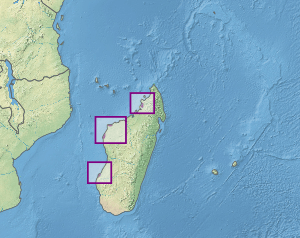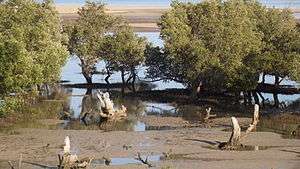Madagascar mangroves
| Madagascar mangroves | |
|---|---|
|
Mangroves, between Ifaty and Belalanda | |
 | |
| Ecology | |
| Realm | Afrotropic |
| Biome | Mangroves |
| Borders | Madagascar dry deciduous forests, Madagascar subhumid forests, Madagascar succulent woodlands, Madagascar spiny forests |
| Animals | green turtle, hawksbill turtle, dugong |
| Bird species | Madagascar heron, Madagascar fish eagle |
| Geography | |
| Area | 5,200 km2 (2,000 sq mi) |
| Country | Madagascar |
| Elevation | sea level |
| Coordinates | 17°1′S 44°12′E / 17.017°S 44.200°ECoordinates: 17°1′S 44°12′E / 17.017°S 44.200°E |
| Geology | river sediments |
| Climate type | Tropical monsoon climate (Am), hot semi-arid climate (BSh), and hot desert climate (BWh) |
| Conservation | |
| Conservation status | vulnerable |
| Global 200 | included |
The Madagascar mangroves are a coastal ecoregion in the mangrove forest biome found on the west coast of Madagascar. They are included in the WWF's Global 200 list of most outstanding ecoregions.
Geography
Mangrove swamps are located in flat coastal areas where the ocean tides wash salt water high into the mouths of rivers which are bringing nutrient-rich soil down to the coast. For mangroves to thrive there also needs to be some natural feature such as coral reefs to shelter the coast from ocean storms and the monsoons. In Madagascar they are mostly found on the more sheltered western, Mozambique channel coast, where they stretch along roughly 1,000 kilometres (620 mi) of coastline. The largest areas are in the estuaries of the Betsiboka River (in Bombetoka Bay near the city of Mahajanga), Besalampy, the Mahajamba and South Mahavavy river, and near Maintirano. The climate is warm all along the coast but more humid in the north.[1]
Flora
The mangrove trees found in Madagascar are mainly Rhizophora mucronata, black mangrove (Bruguiera gymnorrhiza), Ceriops tagal, white mangrove (Avicennia marina), Sonneratia alba and Lumnitzera racemosa. Other species are Xylocarpus granatum and Heritiera littoralis.[1]
Fauna
Mangrove swamps, in Madagascar and around the world, are an important habitat for wildlife, they are a vital breeding ground for many species of fish and a feeding place for migratory birds. The waters of the Madagascar mangroves are rich in fish and other animals such as waterbirds, crocodiles, green turtle (Chelonia mydas), hawksbill turtle (Eretmochelys imbricata), and dugongs. Birds the African spoonbill, great egret, sakalava rail and grey heron. Much of this wildlife is endemic to Madagascar. The many fish found in the waters include the families Mugelidae, Serranidae, Carangidae, Gerridae, Hemiramphidae, Plectrorhynchidae and Elopidae. Neighbouring coral reefs are also extremely diverse.[1]
Threats and conservation
Mangroves are vulnerable to clearance for timber, urban expansion, overfishing, and erosion in the highlands. Activities such as rice growing, salt-panning and shrimp cultivation are also threats. Urban areas near the mangroves include the cities Toliara and Mahajanga. Mananara Nord National Park protects some mangrove swamps.[1]
See also
References
- 1 2 3 4 Tognetii, S. (2004). "119 – Madagascar Mangroves". In Burgess, N.; D'Amico Hales, J.; Underwood, E.; et al. Terrestrial Ecoregions of Africa and Madagascar: A Conservation Assessment. World Wildlife Fund Ecoregion Assessments (2nd ed.). Washington D.C.: Island Press. pp. 425–426. ISBN 978-1559633642. Archived from the original (PDF) on 2016-11-01.
External links
- "Madagascar Mangroves". Terrestrial Ecoregions. World Wildlife Fund.
